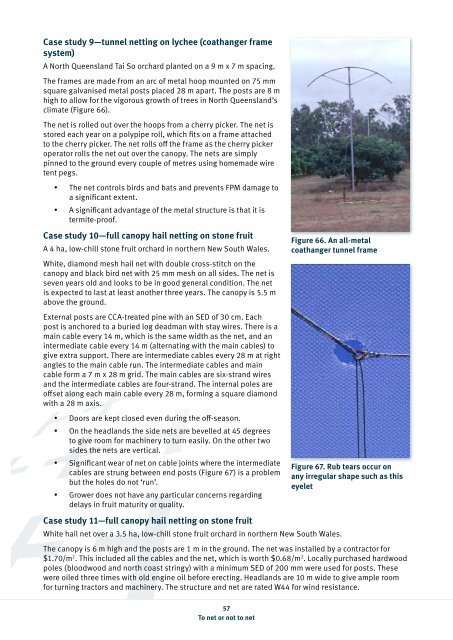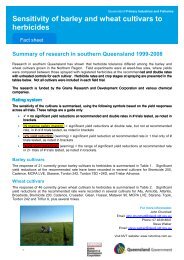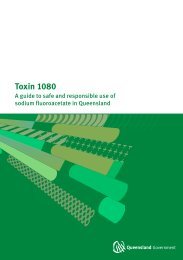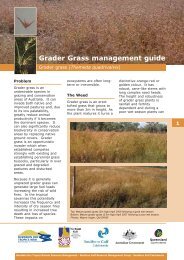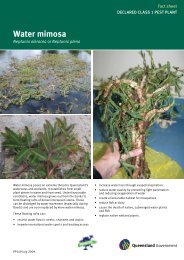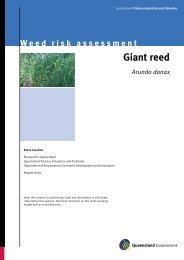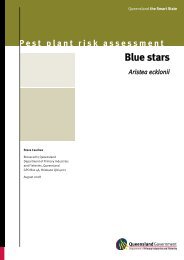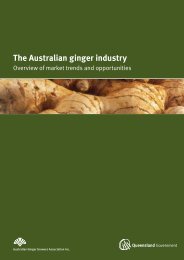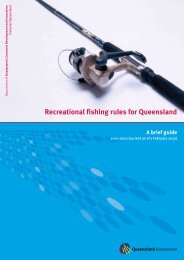To net or not to net - 3rd edition - Department of Primary Industries
To net or not to net - 3rd edition - Department of Primary Industries
To net or not to net - 3rd edition - Department of Primary Industries
Create successful ePaper yourself
Turn your PDF publications into a flip-book with our unique Google optimized e-Paper software.
Case study 9—tunnel <strong>net</strong>ting on lychee (coathanger frame<br />
system)<br />
A N<strong>or</strong>th Queensland Tai So <strong>or</strong>chard planted on a 9 m x 7 m spacing.<br />
The frames are made from an arc <strong>of</strong> metal hoop mounted on 75 mm<br />
square galvanised metal posts placed 28 m apart. The posts are 8 m<br />
high <strong>to</strong> allow f<strong>or</strong> the vig<strong>or</strong>ous growth <strong>of</strong> trees in N<strong>or</strong>th Queensland’s<br />
climate (Figure 66).<br />
The <strong>net</strong> is rolled out over the hoops from a cherry picker. The <strong>net</strong> is<br />
st<strong>or</strong>ed each year on a polypipe roll, which fits on a frame attached<br />
<strong>to</strong> the cherry picker. The <strong>net</strong> rolls <strong>of</strong>f the frame as the cherry picker<br />
operat<strong>or</strong> rolls the <strong>net</strong> out over the canopy. The <strong>net</strong>s are simply<br />
pinned <strong>to</strong> the ground every couple <strong>of</strong> metres using homemade wire<br />
tent pegs.<br />
•<br />
•<br />
The <strong>net</strong> controls birds and bats and prevents FPM damage <strong>to</strong><br />
a significant extent.<br />
A significant advantage <strong>of</strong> the metal structure is that it is<br />
termite-pro<strong>of</strong>.<br />
Case study 10—full canopy hail <strong>net</strong>ting on s<strong>to</strong>ne fruit<br />
A 4 ha, low-chill s<strong>to</strong>ne fruit <strong>or</strong>chard in n<strong>or</strong>thern New South Wales.<br />
White, diamond mesh hail <strong>net</strong> with double cross-stitch on the<br />
canopy and black bird <strong>net</strong> with 25 mm mesh on all sides. The <strong>net</strong> is<br />
seven years old and looks <strong>to</strong> be in good general condition. The <strong>net</strong><br />
is expected <strong>to</strong> last at least a<strong>not</strong>her three years. The canopy is 5.5 m<br />
above the ground.<br />
External posts are CCA-treated pine with an SED <strong>of</strong> 30 cm. Each<br />
post is anch<strong>or</strong>ed <strong>to</strong> a buried log deadman with stay wires. There is a<br />
main cable every 14 m, which is the same width as the <strong>net</strong>, and an<br />
intermediate cable every 14 m (alternating with the main cables) <strong>to</strong><br />
give extra supp<strong>or</strong>t. There are intermediate cables every 28 m at right<br />
angles <strong>to</strong> the main cable run. The intermediate cables and main<br />
cable f<strong>or</strong>m a 7 m x 28 m grid. The main cables are six-strand wires<br />
and the intermediate cables are four-strand. The internal poles are<br />
<strong>of</strong>fset along each main cable every 28 m, f<strong>or</strong>ming a square diamond<br />
with a 28 m axis.<br />
•<br />
•<br />
•<br />
•<br />
Do<strong>or</strong>s are kept closed even during the <strong>of</strong>f-season.<br />
On the headlands the side <strong>net</strong>s are bevelled at 45 degrees<br />
<strong>to</strong> give room f<strong>or</strong> machinery <strong>to</strong> turn easily. On the other two<br />
sides the <strong>net</strong>s are vertical.<br />
Significant wear <strong>of</strong> <strong>net</strong> on cable joints where the intermediate<br />
cables are strung between end posts (Figure 67) is a problem<br />
but the holes do <strong>not</strong> ‘run’.<br />
Grower does <strong>not</strong> have any particular concerns regarding<br />
delays in fruit maturity <strong>or</strong> quality.<br />
57<br />
<strong>To</strong> <strong>net</strong> <strong>or</strong> <strong>not</strong> <strong>to</strong> <strong>net</strong><br />
Figure 66. An all-metal<br />
coathanger tunnel frame<br />
Case study 11—full canopy hail <strong>net</strong>ting on s<strong>to</strong>ne fruit<br />
White hail <strong>net</strong> over a 3.5 ha, low-chill s<strong>to</strong>ne fruit <strong>or</strong>chard in n<strong>or</strong>thern New South Wales.<br />
Figure 67. Rub tears occur on<br />
any irregular shape such as this<br />
eyelet<br />
The canopy is 6 m high and the posts are 1 m in the ground. The <strong>net</strong> was installed by a contract<strong>or</strong> f<strong>or</strong><br />
$1.70/m 2 . This included all the cables and the <strong>net</strong>, which is w<strong>or</strong>th $0.68/m 2 . Locally purchased hardwood<br />
poles (bloodwood and n<strong>or</strong>th coast stringy) with a minimum SED <strong>of</strong> 200 mm were used f<strong>or</strong> posts. These<br />
were oiled three times with old engine oil bef<strong>or</strong>e erecting. Headlands are 10 m wide <strong>to</strong> give ample room<br />
f<strong>or</strong> turning tract<strong>or</strong>s and machinery. The structure and <strong>net</strong> are rated W44 f<strong>or</strong> wind resistance.


